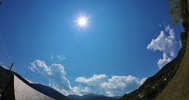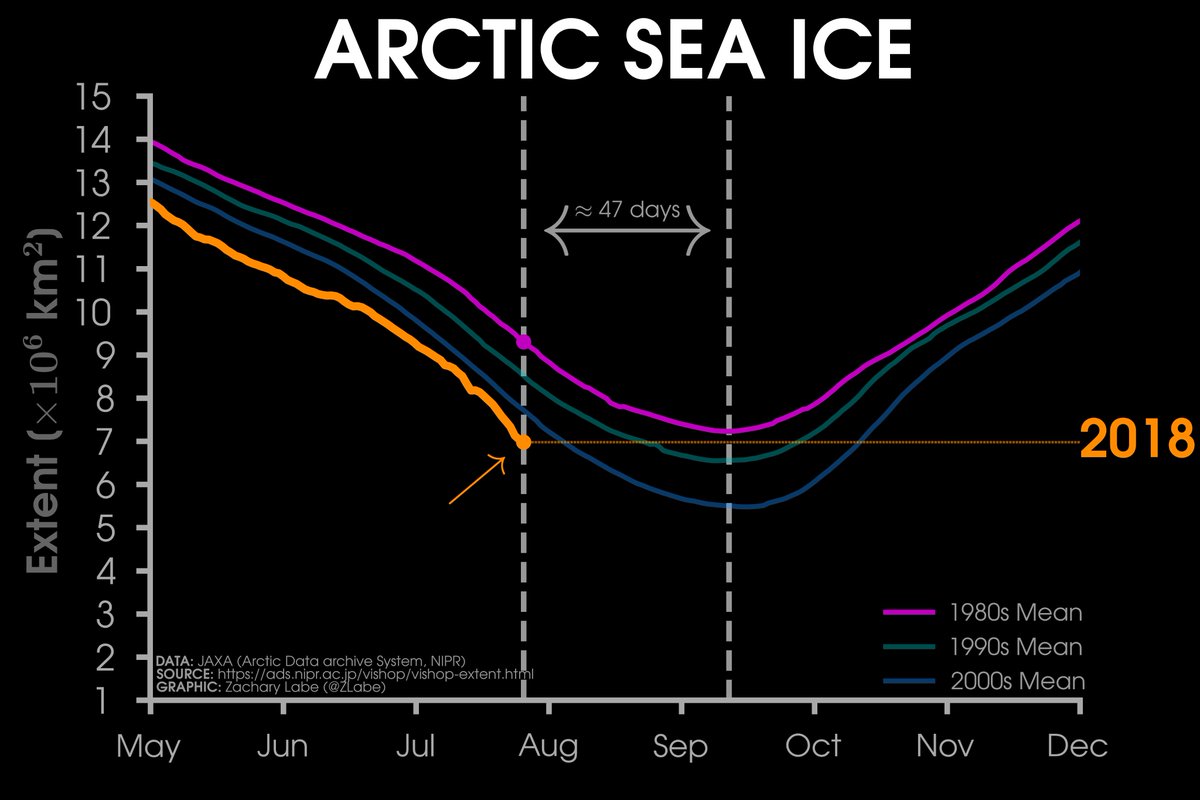July 2108 is in Denmark/Southern Scandinavia already the most sunny July on record since measurements began in 1920. Even the oldest members of society, unless they have immigrated from a warmer country, thus experience a summer of a lifetime.
Juli er nu den solrigeste i dansk vejrhistorie: DMI
Little rain has fallen since April and for this reason, many farmers are selling out of their livestock, as they will not have enough to feed them in the winter and consequently need to save and work with less fodder usually be expected. At the same time many farmers have contracts for the delivery of excess straw to power and heat producing companies. This means, that in spite of their own needs, many are obliged to deliver straw as an energy source for the powerplants, who have moved away from coal in an attempt to be as GREEN as possible. This is not a problem for people who have no animals, but for those that do, they will have difficulty finding excess straw on the market, if they need it.
Right now, with more cattle going to the slaughteries, but with lower production ahead, one may expect higher prices for meat during the coming winter. The ministry of food has allowed ecological/organic farmers to use more solid feed for their cattle without loosing their status as being organic. In the old days farms were smaller and it was desirable for a farm to have som high areas, some low areas and a section of forrest for firewood, so as to insure that the farm in all circustances had a chance to survive dry years.
And what is the situation in Greenland? Try this page:
Home: Polar Portal Then you can move to
Greenland: Polar Portal and then
Surface Conditions: Polar Portal
The overall trend appears to be moderate ice melting and a rather cold and wet summer.
Here is an explanation of the mechanics:
A lot of melting is expected the next few days, but if it can catch up with the expectations of "global warming" is to be seen.
Along the way, I found a Ph.D student who has an active Twitter account
Zack Labe (@ZLabe) | Twitter He has a few tweets that are of interest. For example there is a diagramme of the rising amounts of methane, which has a tendency to get released from stores in the seas, if it warms up and from the Earth itself when the permafrost in the Arctic melts:
In the Twitter postings there was also a link to a time series of the thickness of the Arctic Sea ice:
The above model looks great, but is it true? I tried another model from the Polar Portal, prepared by DMI, and it does seem that things are a bit more icy compared to the end of the 2016 melting season, although we still have a few weeks before the freeze begins again.
Here is another diagramme comparing the ice cover of the present with the past:
According to the above illustration the Arctic is short of 2 million square km of ice, if the past 1980'ies "Sovjet" level of glaciation in the arctic sea is to be achieved again. On the other hand, Nature is in flux all the time, why even try to think that the ice is missing this or that, when the earth already, geologically speaking is in a state of an ice age?
Below is a picture that shows the circulation of air and temperature anomalies from the usual average temperatures in the Northern Hemisphere. At the time of posting, it is showing the period between July 25, and July 29. Parts of Siberia are colder than usual (blue), as is Greenland and surrounding areas, whereas Western Europe and Western US are warmer (red). It is not written where the low and high pressure systems are, but we can deduce from the direction of the wind. In the Northern hemisphere, a high pressure system makes the air flow clockwise, and a low pressure system spins the air counter clockwise. This means that the current high pressure system over Western Russia lets the arctic air down into Russia, where the air warms up and moves over central Europe and up over Scandinavia. And over the Atlantic, there is a low pressure system because we notice the air vortex is spinning counter clockwise. The low pressure system west of the UK brings warmer air from the south which then in the present situation joins the warm air from Eastern Europe to make many parts of Northern Europe warmer than usual, especially since the low pressure system in this instance did not cross the UK and move east, but remained in the West, although this pattern could change in the coming days.

There was also a link to an article, which might hold a clue as to some of the observed weather patterns in Eurasia, and who knows, might even give an idea of how an ice age could be brough about by a period of global warming.
A stratospheric pathway linking a colder Siberia to Barents-Kara Sea sea ice loss
Pengfei Zhang
1,
2,
*, Yutian Wu
2, Isla R. Simpson
3, Karen L. Smith
4, Xiangdong Zhang
5, Bithi De
1 and Patrick Callaghan
3
Science Advances 25 Jul 2018: Vol. 4, no. 7, eaat6025. DOI: 10.1126/sciadv.aat6025
Abstract
Previous studies have extensively investigated the impact of Arctic sea ice anomalies on the midlatitude circulation and associated surface climate in winter. However, there is an ongoing scientific debate regarding whether and how sea ice retreat results in the observed cold anomaly over the adjacent continents. We present a robust “cold Siberia” pattern in the winter following sea ice loss over the Barents-Kara seas in late autumn in an advanced atmospheric general circulation model, with a well-resolved stratosphere. Additional targeted experiments reveal that the stratospheric response to sea ice forcing is crucial in the development of cold conditions over Siberia, indicating the dominant role of the stratospheric pathway compared with the direct response within the troposphere. In particular, the downward influence of the stratospheric circulation anomaly significantly intensifies the ridge near the Ural Mountains and the trough over East Asia.
The persistently intensified ridge and trough favor more frequent cold air outbreaks and colder winters over Siberia. This finding has important implications for improving seasonal climate prediction of midlatitude cold events. The results also suggest that the model performance in representing the stratosphere-troposphere coupling could be an important source of the discrepancy between recent studies.[/QUOTE]Can warm arctic water, a factor when global warming turns into global cooling? It might be as water absorbs more energi, and water an release more humidity to the air than ice. Humid air moving across a cold surface will release moisture and it could be snow.
Below is a model of the ice cover over the seas north of Scandinavia, Northern Russia/ Western Siberia.
Reconstruction of Arctic Barents-Kara sea ice extent changes over the last millennium
July 20, 2018,
Science China Press
Read more at:
Reconstruction of Arctic Barents-Kara sea ice extent changes over the last millennium
Qi Zhang et al, Reconstruction of autumn sea ice extent changes since AD1289 in the Barents-Kara Sea, Arctic,
Science China Earth Sciences (2018).
DOI: 10.1007/s11430-017-9196-4 [...]
Under the influence of global warming, temperature in the Arctic has increased more significantly than the global average.
However, winter extreme cold events in Eurasia including China, have become frequent in recent years. This trend is obviously contrary to global warming. Severe weather with cold surges, ice-snow and frozen rain occurred in southern China in 2008, and the overwhelming "boss-level" cold wave that attacked almost all of China in 2016 caused heavy casualties and property loss. Scholars believe that these events are closely related to the rapid decline of Arctic sea ice. [...]

What is mysterious in the above diagramme, compared to the earlier graphs, is that the level of ice in the Barents-Kara sea appears to have been lower in earlier parts of the 20th century. Does this not contradict other graphs, and models, or is it just that different areas of the arctic seas have been covered?
Leaving the above criticism for now, at the end of the previous article there was a link to a related article, also by Chinese researchers, which has a useful graphic representation that attempts to explain how there can be cold weather in China and by inference north of China, in Siberia, when the ice has melted in Barents-Kara sea:
Arctic warming to increase Eurasian extreme cold events
May 16, 2017, Chinese Academy of Sciences
Arctic warming to increase Eurasian extreme cold events
https://3c1703fe8d.site.internapcdn.net/newman/csz/news/800/2017/arcticwarmin.jpg
Sketch map of the possible physical process between Arctic warming and Eurasian cold events. Credit: Yao Yao
In the above illustration, which highlights the movement of the jet stream, notice that the high pressure system spins the air clockwisem, whereas the low pressure system does the opposite, thus making things colder for Central and Eastern Asia.
Surprisingly, what we have had the past few months is a series of unusually stable high pressure systems over Western Russia and parts of Scandinavia. Had this happened during winter, would we have witnessed freezing cold in China, as explained by the research papers.







